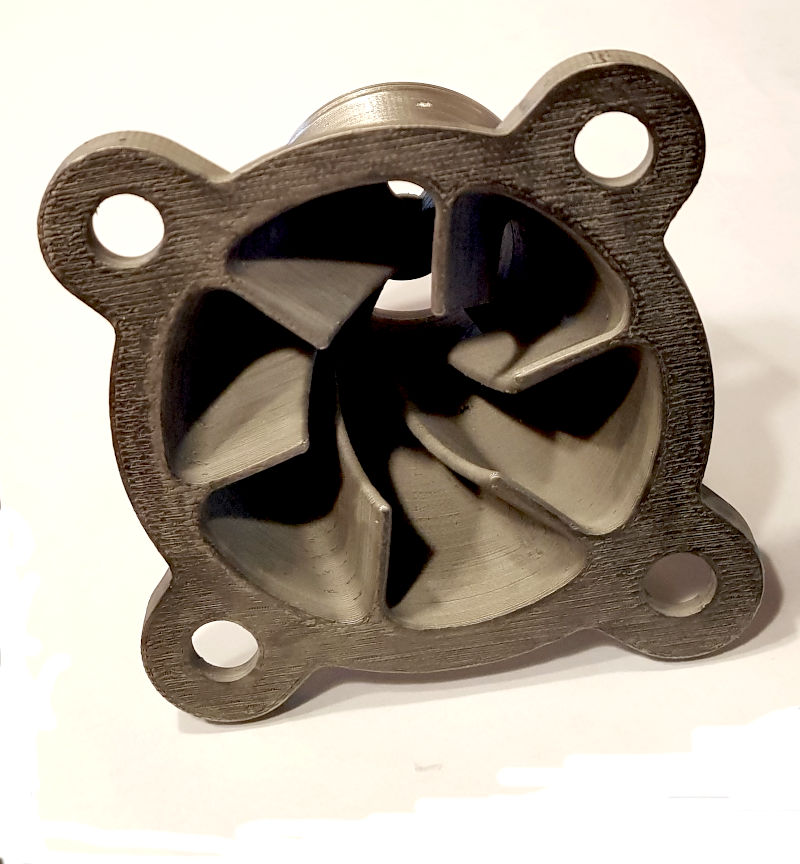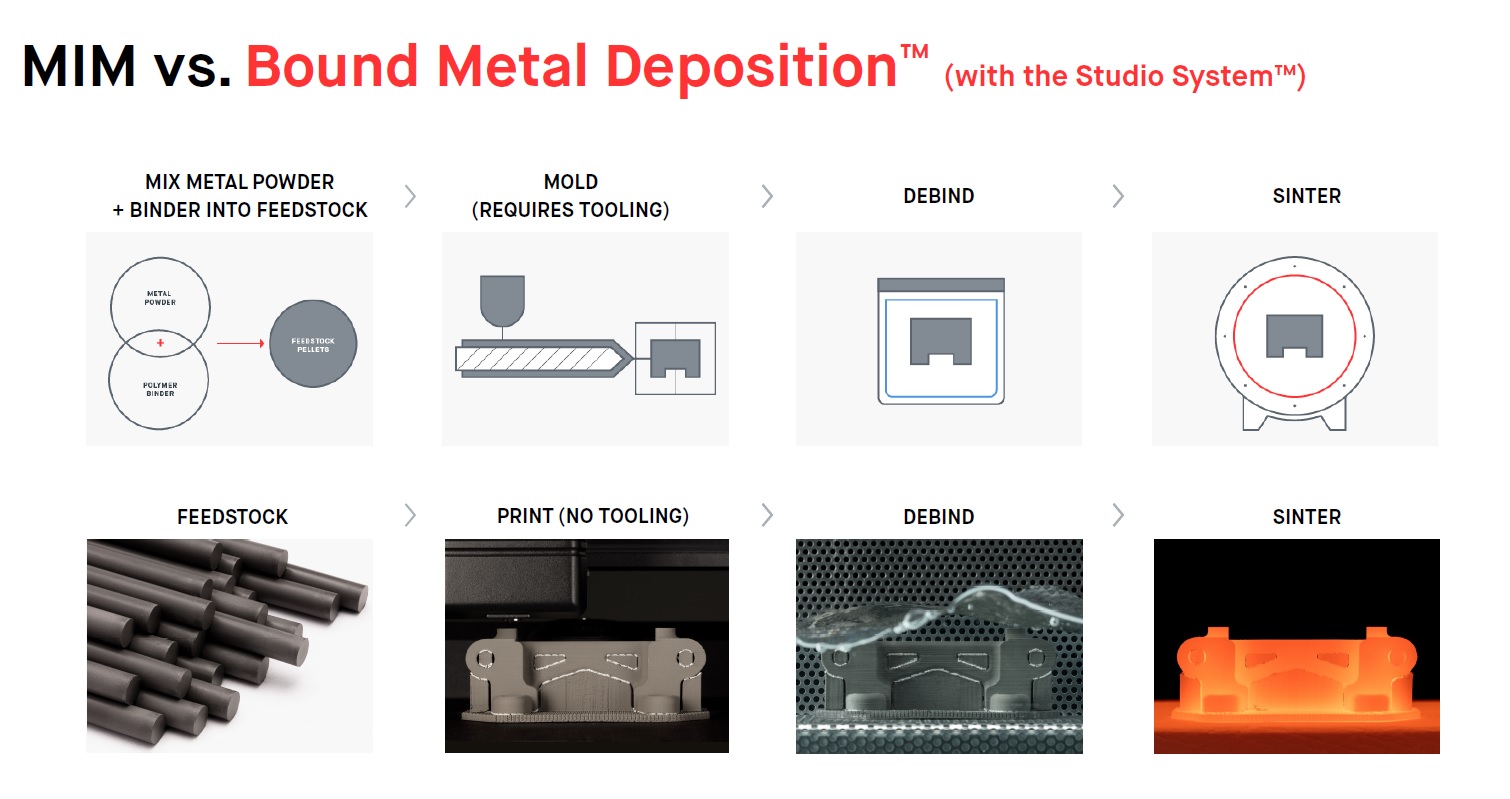Metal 3D Printing
Bypassing the limitations of metal part production processes is a small miracle. We in Metal3D have chosen to offer the most promising metal 3D printing process (Bound Metal Deposition - B.M.D.), a process that provides our customers with all benefits of metal 3d printing on reasonable costs.
Process Details:

Metal3D S.A. operates the integrated metal 3D printing system, called Studio System+® , manufactured by
Desktop Metal USA
. The system is comprised by a Printer, a Debinder and a Sintering Furnace. This printing technology is called BMD (Bound Metal Deposition®).
The Printer is very much close to an FDM plastic printer, although the «raw material», instead of a filament, has the form of bars containing metal powder bonded with a thermoplastic binder. At the printer head, the thermoplastic melts is driven through a nozzle and is deposited on successive layers, building the part. This initial part is called the «Green Body».
The Green Body is subsequently placed inside the Debinder, where, at a relatively elevated temperature and in the presence of a chemical solvent, the thermoplastic binder is removed and a loose metallic component ("«Brown Body»") remains.
The «Brown Body» is then placed in an oven in the presence of inert gas and in a partial vacuum. During Sintering, the temperature in the oven rises up to 1400 ° C, resulting in the particles approaching each other and slowly forming a compact (95-98%) metallic component.
BMD has several similarities to Metal Injection Molding (MIM) technology. In fact, the difference is only in the production of the Green Body. In MIM, the Green Body is produced by injecting the material in a steel mold, although in BMD, the Green Body is build in the Printer.

Typical Applications
- Functional Prototypes
- Spare Parts for Factory Machinery
- Stainless Steel Complex Components
- Fans and Duct Components
- Robotic Applications (End-of-Arm Tooling)
- Housings for Electronics (RFI-protection and Heat Sink)
- Marine Engine Spare Parts
- Single Part Substitution of Component Sets forming Complex Channels for liquids or Gas
- Complex Mechanical Parts for Automations
Materials
316L Stainless Steel
Characterized by its corrosion resistance and good mechanical properties at both high and low temperatures, 316L is a fully austenitic stainless steel.
ABOUT THE MATERIAL:
316L is a common material used in a wide variety of applications, including Chemical and petrochemical processing, Food processing, Laboratory equipment, Medical devices, Marine, Jewelry, Power generation, Petroleum refining, Water treatment, Pulp and paper manufacturing.
17-4PH Stainless Steel
Characterized by its combination of strength, hardness, and corrosion resistance 17-4 PH is a stainless steel ideal for a variety of applications.
ABOUT THE MATERIAL:
17-4 PH is a martensitic precipitation hardened stainless steel. It’s known for its corrosion resistance and high levels of strength and hardness, especially when heat treated. 17-4 can be heat treated to a variety of hardness and toughness levels, allowing users to customize post-sintering properties of the alloy to suit a wide variety of applications, including: Manufacturing machinery, Chemical processing, Food processing, Pump components, Valving, Fasteners, Jigs and Fixtures
H13 Tool Steel
Characterized by its exceptional hot hardness, abrasion resistance, and stability in heat treatment, H13 is a tool steel widely used in both hot and cold work applications.
ABOUT THE MATERIAL:
Tool steel refers to a variety of carbon and alloy steels that are particularly well suited for toolmaking. Their suitability comes from their distinctive hardness, resistance to deformation, and their ability to hold a cutting edge at elevated temperatures. As a result, tool steels are well suited to shape other materials.
H13 is a chromium molybdenum hot work tool steel.
4140 Chromoly Steel
One of the most versatile steels, 4140 is characterized by its toughness, abrasion resistance, and impact resistance, making it a great all-purpose steel for industrial applications.
ABOUT THE MATERIAL:
A versatile alloy with applications that include aerospace, tool and die manufacturing, the oil and gas industries, as well as automotive, agricultural and defense sectors, 4140 steel displays an excellent general tooling and end-use material due to its high strength-to-weight ratio, torsional strength and general toughness.
A low alloy steel that contains chromium, molybdemum, and manganese, 4140 is typically used to create gears, spindles, fixtures, jigs and many other parts, including: Couplings, Connecting Rods, Sheet Metal Tooling, Pump Shafts, and Sprockets.
Technical Specifications
| Max Build Envelope | 240 x 150 x 155 mm |
| Layer Thickness | 0.05 - 0.25 mm |
| Standard Dimensional Accuracy | ±0.8% with a minimum of ±0.5mm |
| Standard Delivery Time | Minimum, 12 working days. Actual delivery time is related to part geometry, lot size, surface finish quality and required post-printing operations |
| As Printed Surface Quality | The as printed part has visible the traces of the building layers, surfaces on contact with support or raft show evidence of the underlying patters |
| Surface Treatment | texturing, glass or sand blasting, polishing, painting, varnishing. |
| Other Post Printing Operations | 5-axis CNC machining, EDM, Surface Grinding, Welding |